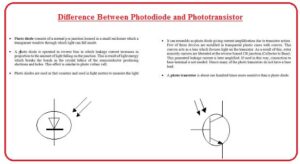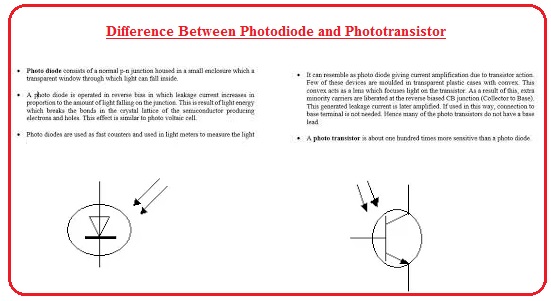 Hello, friends, I hope you all are doing great. In today’s tutorial, we will discuss the Difference Between Photodiode & Phototransistor. The basic difference between photodiode and phototransistor is that for the transformation light in the current in photodiode pn junction diode is uses while in phototransistor transistors is used to transform light in the current. The operation of these two devices is based on the inner photoelectric effect.
Hello, friends, I hope you all are doing great. In today’s tutorial, we will discuss the Difference Between Photodiode & Phototransistor. The basic difference between photodiode and phototransistor is that for the transformation light in the current in photodiode pn junction diode is uses while in phototransistor transistors is used to transform light in the current. The operation of these two devices is based on the inner photoelectric effect.
In a photodiode, a general diode is used that has 2 terminals called anode and cathode. While in a phototransistor normal NPN or PNP transistor is used. The main difference between a transistor and a phototransistor is that in phototransistor there no base terminal. This part of the phototransistor is used to get light from the light source. In today’s post, we will have a detailed look at both photodiode and phototransistor and compare them to find their differences. So let’s get started with Difference Between Photodiode & Phototransistor.
Difference Between Photodiode & Phototransistor
Photodiode
- The device that transforms the light in the electrical energy and belongs to semiconductor family called photodiode.
- It consists of a PN junction like a normal diode.
- The electric current is produced through this device when light photons collided with the body.
- For light collection there is an optical filter, lenses are configured on it.
- Due to large surface area, they show less value of the response.
- Its example is a solar cell
- Their configuration is like the normal diode with the difference that they has the ability to sene light.
- Photonidioe has PIN junction in place of PN junction to increase operation response.
- Photondie diode operates in a reverse-biased state.
- When light falls on the PN junction of diode electrons hole pairs created. This process called the photoelectric effect.
- The hole goes to the cathode and electrons to the anode and current produces
- There are two modes of operation it has a photovoltaic and photoconductive mode
- The output of the photodiode is only current.
- Its output response is fast than the phototransistor.
- It is less sensitive than the phototransistor.
- There are 2 types of biasing that occur in the photodiode forward and reverse bias.
- It used in the solar system for, detection of UV and infrared rays, for light measurements.
Phototransistor
- The transistor that senses the absorbed light and causes the current flow between the emitter and collector called a phototransistor.
- There are 3 main parts it has with the base region that is configured to detection of light.
- It structure is like a transistor with the difference it operates on light
- The output mode of the phototransistor is larger than the photodiode
- It generates both current and voltage.
- Its output response is slower than the photodiode.
- It used in Smoke detectors, compact disc players, invisible light receivers, in laser, etc.
- Its sensitivity level is larger than the photodiode.
- It can only biased in forwarding biased conditions.
Difference between Photodiode and Phototransistor
- The photodiode is pn junction diode converts the light energy to electrical energy and the phototransistor BJT that transforms the light energy into electrical energy.
- There are two terminals for photodiode and phototransistor has three terminals
- The anode and cathode are terminals of the photodiode and the base, emitter and collector are terminals of the phototransistor
- Photodiode comes with P and N structure and the transistor has three region base emitter and collector. The collector is larger and the base is smaller.
- The photodiode has one pn junction and the phototransistor has two pn junction
- PNP and NPN are types of transistors and photodiode has no subtype
- Phototransistor work through forward biased state and photodiodes work in a reverse-biased state
- Photodiodes are only used for light-to-energy conversion and photodiodes are used as switch and amplifier
- The phototransistor is highly sensitive the photodiode
- The response time of the photodiode is less than the phototransistor
- Prices of the photodiode is less than the transistor
That is a detailed post about the difference between phototransistors and photodiodes. If you have any queries ask in comments. I tried my level best to make simple this post for you. Have a good day.






